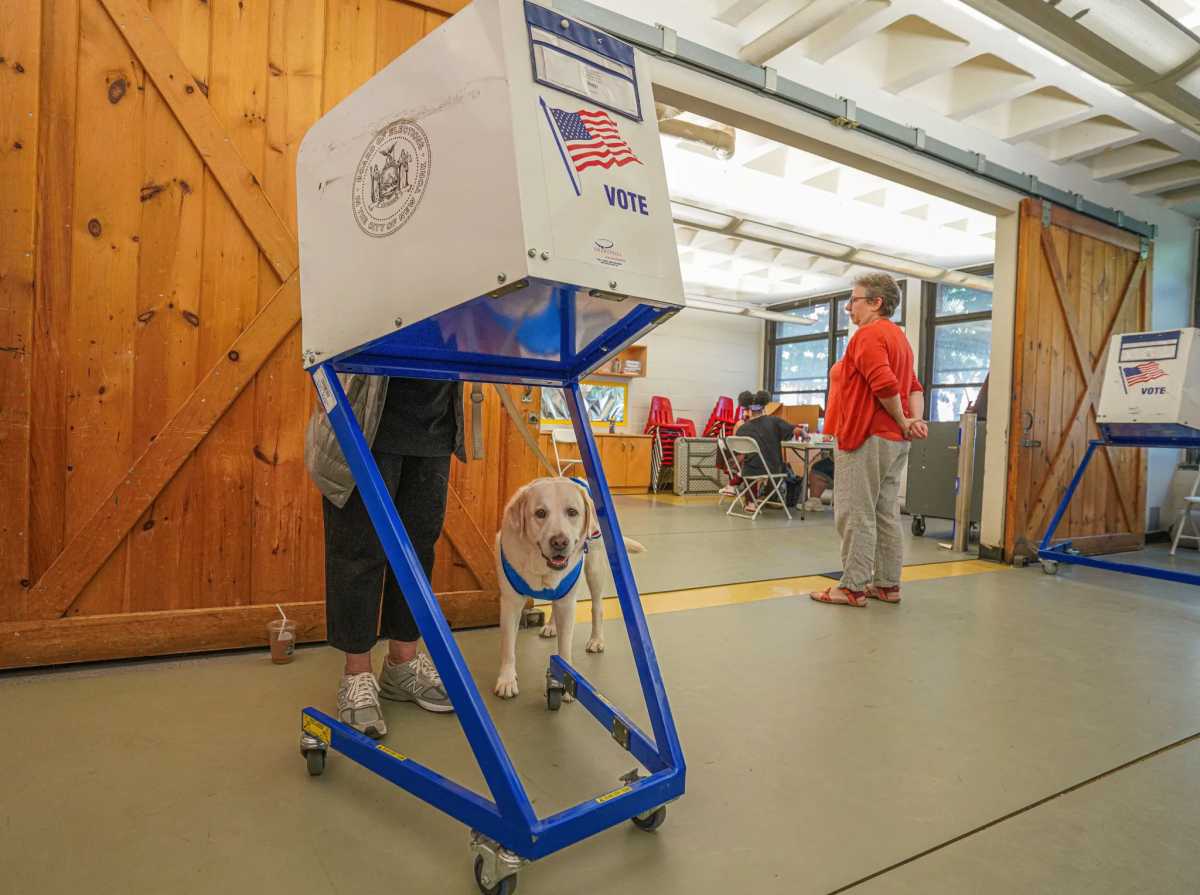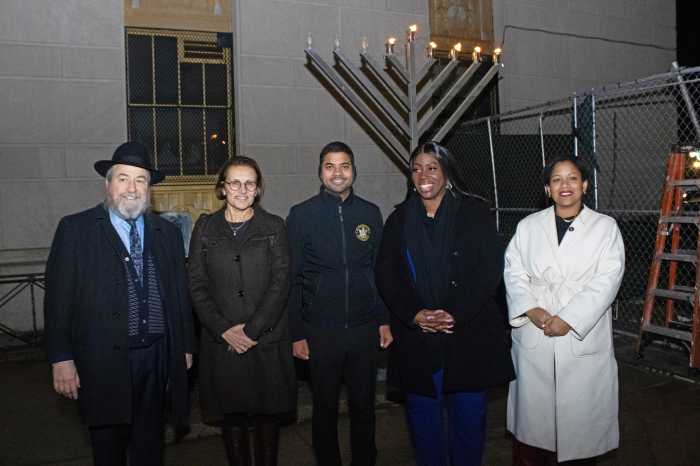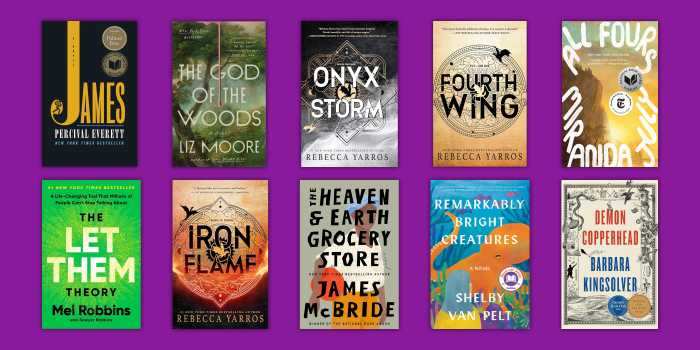I don’t know what I don’t know, but I do know what’s in front of me. That’s why I’m a poll worker.
Projections and punditry are crazy-making, and no one really knows what will happen until the votes are counted. I can, however, help people in our election district and assembly district cast their ballots. There are thousands of us poll workers in New York City, and we are tired.
You can apply to be a poll worker online. Then you take an in-person training, which breaks down the process of Election Day from start (5 a.m.) to finish (when the Return of Canvass is complete). We do a refresher every year. During the pandemic, we did it online.
I signed up in 2016. I’ve worked nearly every election since, and this summer, trained to work Early Voting, which we started having in 2019. Around 250,000 people voted early in New York State in ’19.
As of Nov. 4, over one million people had voted in New York City alone. That’s out of about three million active voters in the city as of February of this year.
Last Saturday, I went to the first day of Early Voting.
My dog Tigger and I joined a line that went around the corner. Poll workers told us we would get in within 30 to 40 minutes.
Campaigners from the Working Families Party (WFP) stood the prescribed distance from the entrance and handed out information. A lot of Democrats run on both their party and the WFP line, and if the WFP gets a certain percentage of the vote, they keep getting listed on the ballot. I saw a lot of people carrying the info with them into the privacy booths; some voters show up with recommended slates from their union, or local political club. That’s allowed.
When I got in, I was sent over to one of the ballot tables. I’d brought my bar-coded fob, and the Table Inspector scanned it into the E-poll book. The printer spat out a ballot with my specific races and ballot propositions.
It’s a big ballot…two-pages, two-sided. In Queens, the ballots are in three languages (usually English, Spanish, and Chinese, Korean or one of the Near East languages), I took it to a privacy booth and spent some time bubbling in my choices.
There is also a table full of translators to make sure the voters know what’s on the ballot. Occasionally someone speaks a language we don’t have a translator for. Often someone else in the room can speak it. You can almost always find someone who speaks Greek in Astoria. They were immigrants a couple generations ago. Now we see adults bringing their parents, who emigrated from the old country, and translating for them in Spanish and Bengali and Hindu and so on. Some families show up en masse to vote. They say 167 languages are spoken in Queens, and I believe it.
On my ballot, along with the presidential, my congressional representative (AOC) is up for re-election in addition to one of our senators (Gillibrand). Two county-wide slates of judges, our state assemblymember, and state senator are also on the ballot. There are six ballot proposals.
Saturday, I waited for the next available scanner, and slid my pages in. I got my “I Voted Early” sticker and went home to review the Early Voting handbook.
Election day workers must be at their assigned polling place one hour before the polls open. During Early Voting, that’s 7 a.m. On Election Day, it’s 5 a.m. That’s a question on the test, and you’d better get it right. Early Voting runs until 5 p.m. on the weekends, and 8 p.m. during the week. While many people thank us for volunteering, we do get paid. It’s a per diem, for days which range from 10 hours to 17-plus hours, with taxes taken out, and a W-2 in January.
On Sunday, I was assigned to Scanner A, and it was my job to take off the seals that had been put there the night before, boot up the machine, make a note of the Public Count (the number of votes this election) and the Protected Count (the total number of votes cast on the machine since it was activated), and print out a Start of Day tape.
Early Voting is in a multi-purpose room at the Variety Boys & Girls Club in Astoria. There’s a proscenium stage at one end (curtains drawn), and the walls are decorated with colorful signs, posters, and stickers. The room seemed smaller than I remembered, packed with Election District carts, privacy booths, printer cabinets, and tables with pens, masks, stickers, peoples’ coats, and bags. It’s been a warm autumn, and we got sweaty fast.
More than a dozen of us scattered to our tasks while the site coordinators made sure everyone knew what they were doing and took our timecards. The polling place rises and falls on the skills of the coordinators. They are usually veteran poll workers who’ve been selected because they know what they are doing. The coordinators everyone likes to work with bring coffee and tea and water, and maybe some Dunkin’ Munchkins, which they pay for themselves.
Just before 8 a.m., we gathered for a quick stand-up. We were told that the first day’s totals were among the highest since Early Voting began, and we could expect similar numbers on Sunday. They had run out of stickers Saturday, which is unheard of. We were to stay off social media, take our breaks in a timely fashion (you get two breaks of 45 minutes to an hour), and always be courteous and professional.
There are some arcane rules: you can’t wear a hat in the polling place unless it is for religious purposes. You can’t take photos in the room (though many people do).
Unless we are specifically asked for help, we are not allowed to touch the ballots. We must stay at least five feet from the scanner (unless it barfs the ballot back out, in which case we are allowed to look at the screen to assist the voter). Dogs are allowed, and many voters bring them.
As 8 a.m. approached, one of the coordinators led us in a cheer of “Team Varsity!” and it was time to open the polls. There was already a line.
It stayed crowded all day. The two other scanners also had attendants, and we repeated the same instructions over and over: Put the two pages in one at a time; no, it doesn’t matter which direction. (Except when it did, and the scanner returned the ballot. We just had them turn it over, and it went through).
Some people turned up in costume: A man dressed as a purple M&M (complete with purple glitter in his hair) and his twins in a stroller dressed as mini-M&Ms. A woman in a Cruella de Vil wig dressed her dogs in Dalmatian costumes.
Because of the ballots packed with choices, people tended to spend a long time in the privacy booths. By mid-afternoon they brought more of them into the already-crowded room. We had lines for the scanners, too, and worked around it when one of them decided to take a nap.
I took a nap when I went home for my first break. It helped.
We served over 1,000 voters on Sunday; we ran out of stickers again (but were able to give out “I Early Voted” bracelets). I sometimes joke that the reason people vote is to get the sticker, and I think there’s more than a grain of truth to that. This year’s stickers are all right. There’s nothing noteworthy about the design. A couple of years ago, we had stickers inspired by the subway map. Those were nice.
The voters were serious about casting their ballots. Some came and went without a word. Some came in with rolling suitcases, because you know, sometimes New Yorkers need their things around them.
Some were on their way to or from work. I saw medical providers in scrubs, postal workers, Parks & Rec staff, and workers wearing jackets with their union affiliation.
Some voters stuck around for a few minutes, wanting to know how it was going, talking about how anxious they were. Some did a fist pump when they voted or wanted to shake our hands.
One woman crossed her fingers and said a prayer. Some parents let their children feed the ballots in, and we gave them “Future Voter” stickers. One of my first memories is being in my dad’s arms as he went into a voting booth, and I watched him flip the switches and pull the big lever. (We had Voting Machines in those days!)
When someone was casting a ballot for the first time, a table worker would yell: FIRST TIME VOTER, and we’d all clap and cheer.
(What if they don’t want that, one of my colleagues remarked? Nah, it’s not bad, another replied. It’s like singing Happy Birthday.)
My next shift took me outside the room where it happens, and I worked as a greeter to the voters coming in. There are two entrances to the building, one with stairs and the other with a slightly steep ramp as well one with a gentler incline, made of aluminum that goes BOOM BOOM BOOM when anyone walks on it.
The Club is a long, low building and the room we were working in is called the Cubby Broccoli Dramatic Theater (I don’t really think cruciferous vegetables are all that dramatic. Give me asparagus). There’s also a 25-yard lap pool, a gym, and classrooms downstairs for various activities.
Like a lot of things in New York City, it’s a little old, a little run down, and very much loved. It smells of chlorine. People walked in, took a breath, and said: I grew up here, I learned to swim here, I still play in the gym.
Since it was a weekday, the pace picked up when the local schools let out, as buses dropped groups of kids off, parents escorted their progeny in swimsuits and bathing caps to the pool, and other parents waited for their kids to finish, toddlers conked out in their arms.
We greeted the voters with “Welcome to Early Voting!” and thanked them when they left. One woman said, “Do you how many people died so I can do this? It’s essential!”
Another left with a wink and said: “Well, I guess I saved democracy.”
When I thanked another, she stopped and said: “It’s an honor and a privilege.”
Everyone who is in line at closing time gets to vote. I congratulated the last voter of the day on Sunday, and he said: “How about that? I had to do it for him,” and he pointed to his kid in a stroller.
At the end of the day, we write down the updated vote count, take the full ballot box liners out of the bottom of the scanner, and put empty ones in for tomorrow. We seal the ballot bins and give them to our cop, who takes them to the Board of Elections office. There’s a paper ballot for every vote cast.
A couple of years ago, I observed a hand count at Borough Hall for a very close local election. It was intense.
I’m back to work at the polls on Election Day. At 5 a.m. the phrase “I’m getting too old for this shit” comes to mind.
Let’s go, liberty.































